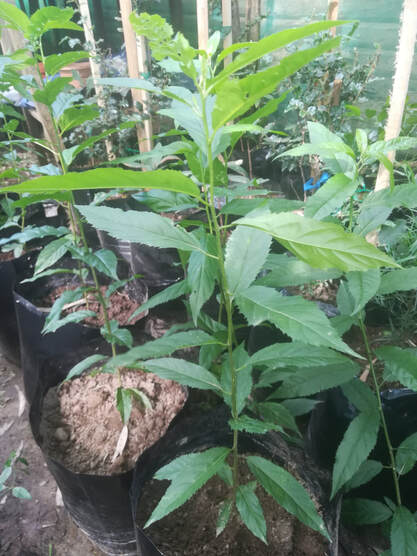|
This week, in our nursery we reported Kiggelaria Africana (wild peach). Kiggelaria Africana is a medium sized tree and occurs in the forest wooded riverine or on rocky outcrops and grassland. The wild peach is a well-known tree on the conservancy and Goliaith Highburg (Oom Twakkie) usually plants it successfully from seed. It grows very well in the bags he has in the nursery.  Bright orange seeds of the Wild peach tree(Kiggelaria africana) Bright orange seeds of the Wild peach tree(Kiggelaria africana) On the conservancy, Oom Twakkie obtains seeds and plants them in pots or bags with compost with the sprayers to water them in the nursery. The fruit is round, yellowish green and covered with hairs. The seeds are black, with a bright red orange covering and yellowish green flowers. An interesting fact is that bats are the main pollinators of this tree. It thrives on the edges of forests and is often encountered in kloofs and rocky outcrops of grass-covered mountain slopes. It is found between moist slopes above the Riversdale coastal plain and areas like Zuurberg that experience mostly summer rainfall. ''It's one of my favorite trees" says Aileen Anderson, the manager of our conservancy. And indeed the wildpeach tree that stands on her deck is magnificent, with round balls and bright orange seeds inside. The tree sits above the best celphone reception for Aileen's office so this wise tree has overheard many interesting conservancy-related conversations. The birds also love it and so Aileen's deck is always filled with busy birds. This beautiful tree is named after Franz Kiggelaer and the Latin word africana means "comes from Africa".The hardish pink-brown wood can be used for timber (furniture). It was also once used for the wagon spokes of ox wagon wheels. Some people believe that touching this tree will attract lightning. In South Sotho culture, medicince is made from it to protect kraals. The fruit is also toxic and used for traditional medicine such as skin problems. An extract of the bark can be used for treating sores and wounds and the seeds were eaten during famine. What a useful tree! Oom Twakkie says that you just plant the seeds into your compost soil and they grow. Young trees grow fast as observed in the nursery and they flower from about two years old. It forms a good windbreak for your property. When you plant the trees, Omm Twakkie recommends using moderate amount of water and a place in the sun. Another tip is to add your compost to the soil when planting and the tree grows in both winter as well as summer rainfall. This tree attracts birds and butterflies .This lovely pioneer plant will also feed your honeybees. Wow...What an amazing tree! We are lucky to have this species here on our conservancy. References: http://pza.sanbi.org/kiggelaria-africana Van Wyk, B., 2013. Field guide to trees of southern Africa. Penguin Random House South Africa.
0 Comments
Your comment will be posted after it is approved.
Leave a Reply. |
AuthorGVB Conservancy Staff Archives
May 2024
Categories |



 RSS Feed
RSS Feed






